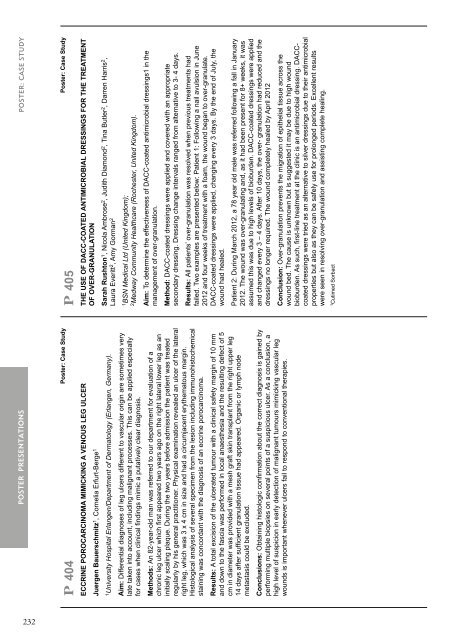You also want an ePaper? Increase the reach of your titles
YUMPU automatically turns print PDFs into web optimized ePapers that Google loves.
POSTER PRESENTATIONS<br />
P 404<br />
ECCRINE POROCARCINOMA MIMICKING A VENOUS LEG ULCER<br />
Poster: Case Study<br />
Juergen Bauerschmitz 1 , Cornelia Erfurt-Berge 1<br />
1 University Hospital Erlangen/Department of Dermatology (Erlangen, Germany).<br />
Aim: Differential diagnoses of leg ulcers different to vascular origin are sometimes very<br />
late taken into account, including malignant processes. This can be applied especially<br />
for cases when clinical findings mimic a putatively clear diagnosis.<br />
Methods: An 82-year-old man was referred to our department for evaluation of a<br />
chronic leg ulcer which first appeared two years ago on the right lateral lower leg as an<br />
initially scaling plaque. During the two years before admission the patient was treated<br />
regularly by his general practitioner. Physical examination revealed an ulcer of the lateral<br />
right leg, which was 3 x 4 cm in size and had a circumjacent erythematous margin.<br />
Histological analysis of several specimen from the lesion including immunohistochemical<br />
staining was concordant with the diagnosis of an eccrine porocarcinoma.<br />
Results: A total excision of the ulcerated tumour with a clinical safety margin of 10 mm<br />
and down to the fascia was performed in local anaesthesia and the resulting defect of 5<br />
cm in diameter was provided with a mesh graft skin transplant from the right upper leg<br />
14 days after sufficient granulation tissue had appeared. Organic or lymph node<br />
metastasis could be excluded.<br />
Conclusions: Obtaining histologic confirmation about the correct diagnosis is gained by<br />
performing multiple biopsies on several points of a suspicious ulcer. As a conclusion, a<br />
high level of suspicion in early detection of malignant tumours mimicking vascular leg<br />
wounds is important whenever ulcers fail to respond to conventional therapies.<br />
POSTER: CASE STUDY<br />
P 405<br />
Poster: Case Study<br />
THE USE OF DACC-COATED ANTIMICROBIAL DRESSINGS FOR THE TREATMENT<br />
OF OVER-GRANULATION<br />
Sarah Rushton 1 , Nicola Ambrose 2 , Judith Diamond 2 , Tina Butler 2 , Darren Harris 2 ,<br />
Laura Everitt 2 , Amy Gorman 2<br />
1 BSN Medical Ltd (United Kingdom);<br />
2 Medway Community Healthcare (Rochester, United Kingdom).<br />
Aim: To determine the effectiveness of DACC-coated antimicrobial dressings1 in the<br />
management of over-granulation.<br />
Method: DACC-coated dressings were applied and covered with an appropriate<br />
secondary dressing. Dressing change intervals ranged from alternative to 3- 4 days.<br />
Results: All patients’ over-granulation was resolved when previous treatments had<br />
failed. Two examples are presented below: Patient 1: Following a nail avulsion in June<br />
2012 and four weeks of treatment with a foam, the wound began to over-granulate.<br />
DACC-coated dressings were applied, changing every 3 days. By the end of July, the<br />
wound had healed.<br />
Patient 2: During March 2012, a 78 year old male was referred following a fall in January<br />
2012. The wound was over-granulating and, as it had been present for 8+ weeks, it was<br />
assumed this was due to high levels of bioburden. DACC-coated dressings were applied<br />
and changed every 3 – 4 days. After 10 days, the over- granulation had reduced and the<br />
dressings no longer required. The wound completely healed by April 2012<br />
Conclusion: Over-granulation prevents the migration of epithelial tissue across the<br />
wound bed. The cause is unknown but is suggested it may be due to high wound<br />
bioburden. As such, first-line treatment at the clinic is an antimicrobial dressing. DACCcoated<br />
dressings were tried as an alternative to silver dressings due to their antimicrobial<br />
properties but also as they can be safely use for prolonged periods. Excellent results<br />
were seen in resolving over-granulation and assisting complete healing.<br />
1 Cutimed Sorbact<br />
232






